Patterns and Drivers of Aboveground Insect Diversity along Ecological Transect in Temperate Grazed Steppes of Eastern Eurasian
Abstract
Simple Summary
Abstract
1. Introduction
2. Materials and Methods
2.1. Study Area
2.2. Insect Sampling and Identification
2.3. Vegetation Measurement
2.4. Environmental Variables
2.5. Data Analyses
3. Results
3.1. Species α- and β-Diversity
3.2. The Effect of Environmental Variables on Insect Diversity
3.3. Response of Different Orders and Species of Insects to Plant Attributes
4. Discussion
5. Conclusions
Supplementary Materials
Author Contributions
Funding
Institutional Review Board Statement
Data Availability Statement
Acknowledgments
Conflicts of Interest
References
- Woodward, S.L. The temperate grassland biome. In Grassland Biomes; Woodward, S.L., Ed.; Greenwood Press: London, UK, 2008. [Google Scholar]
- Jiao, C.C.; Yu, G.R.; Ge, J.P.; Chen, X.; Zhang, C.; He, N.P.; Chen, Z.; Hu, Z.M. Analysis of spatial and temporal patterns of aboveground net primary productivity in the Eurasian steppe region from 1982 to 2013. Ecol. Evol. 2017, 7, 5149–5162. [Google Scholar] [CrossRef] [PubMed]
- Hou, X.Y. Discussion on setting up ecological transects in Eastern Eurasian temperate steppe. Chin. J. Grassl. 2012, 33, 108–112. [Google Scholar]
- Gao, L.; Hou, X.Y.; Wang, Z.; Han, W.J.; Yun, X.J. Effects of heavy grazing on soil nitrogen mineralization and temperature sensitivity along the Eastern Eurasia Steppe Transect. Acta Ecol. Sin. 2019, 39, 5095–5105. Available online: http://CNKI:SUN:STXB.0.2019-14-008 (accessed on 2 December 2022).
- Petermann, J.S.; Buzhdygan, O.Y. Grassland biodiversity. Curr. Biol. 2021, 31, R1195–R1201. [Google Scholar] [CrossRef]
- Quigley, T.P.; Amdam, G.V.; Harwood, G.H. Honey bees as bioindicators of changing global agricultural landscapes. Curr. Opin. Insect Sci. 2019, 35, 132–137. [Google Scholar] [CrossRef] [PubMed]
- Gerlach, J.; Samways, M.; Pryke, J. Terrestrial invertebrates as bioindicators: An overview of available taxonomic groups. J. Insect Conserv. 2013, 17, 831–850. [Google Scholar] [CrossRef]
- Mendez-Rojas, D.M.M.; Cultid-Medina, C.; Escobar, F. Influence of land use change on rove beetle diversity: A systematic review and global meta-analysis of a mega-diverse insect group. Ecol. Indic. 2021, 122, 107239. [Google Scholar] [CrossRef]
- Miao, B.G.; Peng, Y.Q.; Yang, D.R.; Kubota, Y.; Economo, E.P.; Liu, C. Climate and land-use interactively shape butterfly diversity in tropical rainforest and savanna ecosystems of southwestern China. Insect Sci. 2021, 28, 1109–1120. [Google Scholar] [CrossRef] [PubMed]
- Bale, J.S.; Masters, G.J.; Hodkinson, I.D.; Awmack, C.; Bezemer, T.M.; Brown, V.K.; Butterfield, J.; Buse, A.; Coulson, J.C.; Farrar, J.; et al. Herbivory in global climate change research: Direct effects of rising temperature on insect herbivores. Glob. Chang. Biol. 2002, 8, 1–16. [Google Scholar] [CrossRef]
- Brehm, G.; Süssenbach, D.; Fiedler, K. Unique elevational diversity patterns of geometrid moths in an Andean montane rainforest. Ecography 2003, 26, 456–466. [Google Scholar] [CrossRef]
- Axmacher, J.C.; Brehm, G.; Hemp, A.; Tünte, H.; Lyaruu, H.V.M.; Müller-Hohenstein, K.; Fiedler, K. Determinants of diversity in afrotropical herbivorous insects (Lepidoptera: Geometridae): Plant diversity, vegetation structure or abiotic factors? J. Biogeogr. 2009, 36, 337–349. [Google Scholar] [CrossRef]
- Sponseller, R. Precipitation pulses and soil CO2 flux in a Sonoran Desert ecosystem. Glob. Chang. Biol. 2010, 13, 426–436. [Google Scholar] [CrossRef]
- Zhu, H.; Wang, D.L.; Wang, L.; Bai, Y.G.; Fang, J.; Liu, J. The effects of large herbivore grazing on meadow steppe plant and insect diversity. J. Appl. Ecol. 2012, 49, 1075–1083. [Google Scholar] [CrossRef]
- Sangle, P.M.; Satpute, S.B.; Khan, F.S.; Rode, N.S. Impact of climate change on insects. Trends Biosci. 2015, 8, 3579–3582. [Google Scholar]
- Zhu, H.; Wang, D.; Guo, Q.; Liu, J.; Wang, L. Interactive effects of large herbivores and plant diversity on insect abundance in a meadow steppe in China. Agric. Ecosyst. Environ. 2015, 212, 245–252. [Google Scholar] [CrossRef]
- Jerrentrup, J.S.; Wrage-Monnig, N.; Rover, K.U.; Isselstein, J. Grazing intensity affects insect diversity via sward structure and heterogeneity in a long-term experiment. J. Appl. Ecol. 2014, 51, 968–977. [Google Scholar] [CrossRef]
- Zhao, Z.; Reddy, G.V.; Wei, S.; Zhu, M.; Zhang, K.; Yu, H.; Wang, Z.; Jiang, Q.; Zhang, R. Plant cover associated with aboveground net primary productivity (ANPP) mediates insect community composition in steppes of Northwest China. J. Asia Pac. Entomol. 2018, 21, 361–366. [Google Scholar] [CrossRef]
- Poyry, J.; Lindgren, S.; Salminen, J.; Kuussaari, M. Restoration of butterfly and moth communities in semi-natural grasslands by cattle grazing. Ecol. Appl. 2004, 14, 1656–1670. [Google Scholar] [CrossRef]
- Jiang, L.; Wang, S.; Pang, Z.; Wang, C.; Kardol, P.; Zhou, X.; Rui, Y.; Lan, Z.C.; Wang, Y.; Xu, X. Grazing modifies inorganic and organic nitrogen uptake by coexisting plant species in alpine grassland. Biol. Fertil. Soils 2016, 52, 211–221. [Google Scholar] [CrossRef]
- Zhu, H.; Wang, W.; Qu, Y.; Fu, J.; Jiang, S.; Wang, D.; Kaplan, I.; Ren, B. Resource-mediated effects of grazing and irrigation on insect diversity in a meadow steppe. Insect Conserv. Divers. 2018, 12, 29–38. [Google Scholar] [CrossRef]
- Ribas, C.R.; Schoereder, J.H.; Pic, M.; Soares, S.M. Tree heterogeneity, resource availability, and larger scale processes regulating arboreal ant species richness. Austral Ecol. 2003, 28, 305–314. [Google Scholar] [CrossRef]
- Vasconcelos, H.L.; Maravalhas, J.B.; Neves, K.C.; Pacheco, R.; Vieira, J.; Camarota, F.C.; Izzo, T.J.; Araújo, G.M. Congruent spatial patterns of ant and tree diversity in neotropical savannas. Biodivers. Conserv. 2019, 28, 1075–1089. [Google Scholar] [CrossRef]
- Zhao, Y.; Ding, Y.; Hou, X.Y.; Li, F.Y.; Han, W.J.; Yun, X. Effects of temperature and grazing on soil organic carbon storage in grasslands along the Eurasian steppe eastern transect. PLoS ONE 2017, 12, e0186980. [Google Scholar] [CrossRef]
- Ren, H.R.; Zhou, G.S.; Zhang, X.S. Estimation of green aboveground biomass of desert steppe in inner Mongolia based on red-edge reflectance curve area method. Biosyst. Eng. 2011, 109, 385–395. [Google Scholar] [CrossRef]
- Schaffers, A.P.; Raemakers, I.P.; Sýkora, K.V.; Ter Braak, C.J. Arthropod assemblages are best predicted by plant species composition. Ecology 2008, 89, 782–794. [Google Scholar] [CrossRef] [PubMed]
- Nonnaizab; Qi, B.Y.; Li, Y.B. Insects of Inner Mongolia China; People Press of Inner Mongolia: Hohhot, China, 1999. [Google Scholar]
- Cao, R. Illustrations of Common Plants in Inner Mongolia; Higher Education Press: Beijing, China, 2017. [Google Scholar]
- R Core Team. R: A Language and Environment for Statistical Computing; R Foundation for Statistical Computing: Vienna, Austria, 2022; Available online: https://www.R-project.org/ (accessed on 11 November 2022).
- Chao, A.; Chiu, C.H.; Hsieh, T.C.; Davis, T.; Nipperess, D.A.; Faith, D.P. Rarefaction and extrapolation of phylogenetic diversity. Methods Ecol. Evol. 2014, 6, 380–388. [Google Scholar] [CrossRef]
- Hsieh, T.C.; Ma, K.H.; Chao, A. iNEXT: An R package for rarefaction and extrapolation of species diversity (Hill numbers). Methods Ecol. Evol. 2016, 7, 1451–1456. [Google Scholar] [CrossRef]
- Oksanen, J.; Blanchet, F.G.; Kindt, R.; Legendre, P.; O’hara, R.B.; Simpson, G.L.; Solymos, P.; Stevens, M.H.; Wagner, H. Vegan: Community Ecology Package; R Foundation for Statistical Computing: Vienna, Austria, 2018; Available online: https://CRAN.R-project.org/package=vegan (accessed on 14 November 2022).
- Mantel, N. The detection of disease clustering and a generalized regression approach. Cancer Res. 1967, 27, 209–220. Available online: https://pubmed.ncbi.nlm.nih.gov/6018555/ (accessed on 2 December 2022).
- Legendre, P.; Fortin, M.J. Spatial pattern and ecological analysis. Vegetatio 1989, 80, 107–138. [Google Scholar] [CrossRef]
- Shipley, B. Confirmatory path analysis in a generalized multilevel context. Ecology 2009, 90, 363–368. [Google Scholar] [CrossRef]
- Laliberte, E.; Tylianakis, J.M. Cascading effects of longterm land-use changes on plant traits and ecosystem functioning. Ecology 2012, 93, 145–155. [Google Scholar] [CrossRef] [PubMed]
- Sanchez, G. PLS Path Modeling with R; Trowchez Editions: Berkeley, CL, USA, 2013. [Google Scholar]
- Bates, D.; Maechler, M.; Bolker, B.; Walker, S. LME4: Linear Mixed-Effects Models Using Eigen and S4. 2014. Available online: https://cran.r-project.org/web/packages/lme4/index.html (accessed on 17 November 2022).
- Enkhtur, K.; Brehm, G.; Boldgiv, B.; Pfeifer, M. Alpha and beta diversity patterns of macro-moths reveal a breakpoint along a latitudinal gradient in Mongolia. Sci. Rep. 2021, 11, 15018. [Google Scholar] [CrossRef] [PubMed]
- Frank, T.; Bramböck, M. Predatory beetles feed more pest beetles at rising temperature. BMC Ecol. 2016, 16, 21. [Google Scholar] [CrossRef] [PubMed]
- De Boeck, H.J.; Lemmens, C.M.; Zavalloni, C.; Gielen, B.; Malchair, S.; Carnol, M.; Merckx, R.; Van den Berge, J.; Ceulemans, R.; Nijs, I. Biomass production in experimental grasslands of different species richness during three years of climate warming. Biogeosciences 2008, 5, 585–594. [Google Scholar] [CrossRef]
- Ma, W.; Liu, Z.; Wang, Z.; Wang, W.; Liang, C.; Tang, Y.; He, J.S.; Fang, J. Climate change alters interannual variation of grassland aboveground productivity: Evidence from a 22-year measurement series in the Inner Mongolian grassland. J. Plant Res. 2010, 123, 509–517. [Google Scholar] [CrossRef]
- Xu, Z.Z.; Zhou, G.S. Effects of water stress and high nocturnal temperature on photosynthesis and nitrogen level of a perennial grass Leymus chinensis. Plant Soil 2005, 269, 131–139. [Google Scholar] [CrossRef]
- De Boeck, H.J.; Lemmens, C.M.; Bossuyt, H.; Malchair, S.; Carnol, M.; Merckx, R.; Nijs, I.; Ceulemans, R. How do climate warming and plant species richness affect water use in experimental grasslands? Plant Soil 2006, 288, 249–261. [Google Scholar] [CrossRef]
- Yan, H.; Liang, C.; Li, Z.; Liu, Z.; Miao, B.; He, C.; Sheng, L. Impact of Precipitation Patterns on Biomass and Species Richness of Annuals in a Dry Steppe. PLoS ONE. 2015, 10, e0125300. [Google Scholar] [CrossRef]
- Yang, Y.; Dou, Y.; An, S. Environmental driving factors affecting plant biomass in natural grassland in the Loess Plateau, China. Ecol. Indic. 2017, 82, 250–259. [Google Scholar] [CrossRef]
- Tsafack, N.; Xie, Y.; Wang, X.; Fattorini, S. Influence of Climate and Local Habitat Characteristics on Carabid Beetle Abundance and Diversity in Northern Chinese Steppes. Insects 2019, 11, 19. [Google Scholar] [CrossRef]
- Joern, A. Disturbance by fire frequency and bison grazing modulate grasshopper assemblages in tallgrass prairie. Ecology 2005, 86, 861–873. [Google Scholar] [CrossRef]
- Pöyry, J.; Luota, M.; Paukkunen, J.; Pykälä, J.; Raatikainen, K.; Kuussaari, M. Different responses of plants and herbivore insects to a gradient of vegetation height: An indicator of the vertebrate grazing intensity and successional age. Oikos 2006, 115, 401–412. [Google Scholar] [CrossRef]
- KÅrösi, Á.; Batáry, P.; Orosz, Á.; Rédei, D.; Báldi, Á. Effects of grazing, vegetation structure and landscape complexity on grassland leafhoppers (Hemiptera: Auchenorrhyncha) and true bugs (Hemiptera: Heteroptera) in Hungary. Insect Conserv. Divers. 2012, 5, 57–66. [Google Scholar] [CrossRef]
- Perner, J.; Wytrykush, C.; Kahmen, A.; Buchmann, N.; Egerer, I.; Creutzburg, S.; Odat, N.; Audorff, V.; Weisser, W.W. Effects of plant diversity, plant productivity and habitat parameters on arthropod abundance in montane European grasslands. Ecography 2005, 28, 429–442. [Google Scholar] [CrossRef]
- Wang, L.; Liu, C.; Alves, D.G.; Frank, D.A.; Wang, D.L. Plant diversity is associated with the amount and spatial structure of soil heterogeneity in meadow steppe of China. Landsc. Ecol. 2015, 30, 1713–1721. [Google Scholar] [CrossRef]
- Haddad, N.M.; Tilman, D.; Haarstad, J.; Ritchie, M.; Knops, J.M.H. Contrasting effects of plant richness and composition on insect communities: A field experiment. Am. Nat. 2001, 158, 17–35. [Google Scholar] [CrossRef] [PubMed]
- Scherber, C.; Eisenhauer, N.; Weisser, W.W.; Schmid, B.; Voigt, W.; Fischer, M.; Schulze, E.D.; Roscher, C.; Weigelt, A.; Allan, E.; et al. Bottom-up effects of plant diversity on multitrophic interactions in a biodiversity experiment. Nature 2010, 468, 553–556. [Google Scholar] [CrossRef]
- Haddad, N.M.; Crutsinger, G.M.; Gross, K.; Haarstad, J.; Knops, J.M.H.; Tilman, D. Plant species loss decreases arthropod diversity and shifts trophic structure. Ecol. Lett. 2009, 12, 1029–1039. [Google Scholar] [CrossRef]
- Specht, J.; Scherber, C.; Unsicker, S.B.; Köhler, G.; Weisser, W.W. Diversity and beyond: Plant functional identity determines herbivore performance. J. Anim. Ecol. 2008, 77, 1047–1055. [Google Scholar] [CrossRef]
- Siemann, E. Experimental tests of effects of plant productivity and diversity on grassland arthropod diversity. Ecology 1998, 79, 2057–2070. [Google Scholar] [CrossRef]
- Dennis, P.; Skartveit, J.; McCracken, D.I.; Pakeman, R.J.; Beaton, K.; Kunaver, A.; Evans, D.M. The effects of livestock grazing on foliar arthropods associated with bird diet in upland grasslands of Scotland. J. Appl. Ecol. 2008, 45, 279–287. [Google Scholar] [CrossRef]
- Sjödin, N.E.; Bengtsson, J.; Ekbom, B. The influence of grazing intensity and landscape composition on the diversity and abundance of flower-visiting insects. J. Appl. Ecol. 2008, 45, 763–772. [Google Scholar] [CrossRef]
- Berner, D.; Blanckenhorn, W.U.; Körner, C. Grasshopper cope with low host plant quality by compensatory feeding and food selection: N limitation challenged. Oikos 2005, 111, 525–533. [Google Scholar] [CrossRef]
- Morris, M.G. The effects of structure and its dynamics on the ecology and conservation of arthropods in British grasslands. Biol. Conserv. 2000, 95, 129–142. [Google Scholar] [CrossRef]
- Wang, L.; Wang, D.L.; Liu, J.S.; Huang, Y.; Hodgkinson, K.C. Diet selection variation of a large herbivore in a feeding experiment with increasing species numbers and different plant functional group combinations. Acta Oecol. 2011, 37, 263–268. [Google Scholar] [CrossRef]
- Kruess, A.; Tscharntke, T. Contrasting responses of plant and insect diversity to variation in grazing intensity. Biol. Conserv. 2002, 106, 293–302. [Google Scholar] [CrossRef]
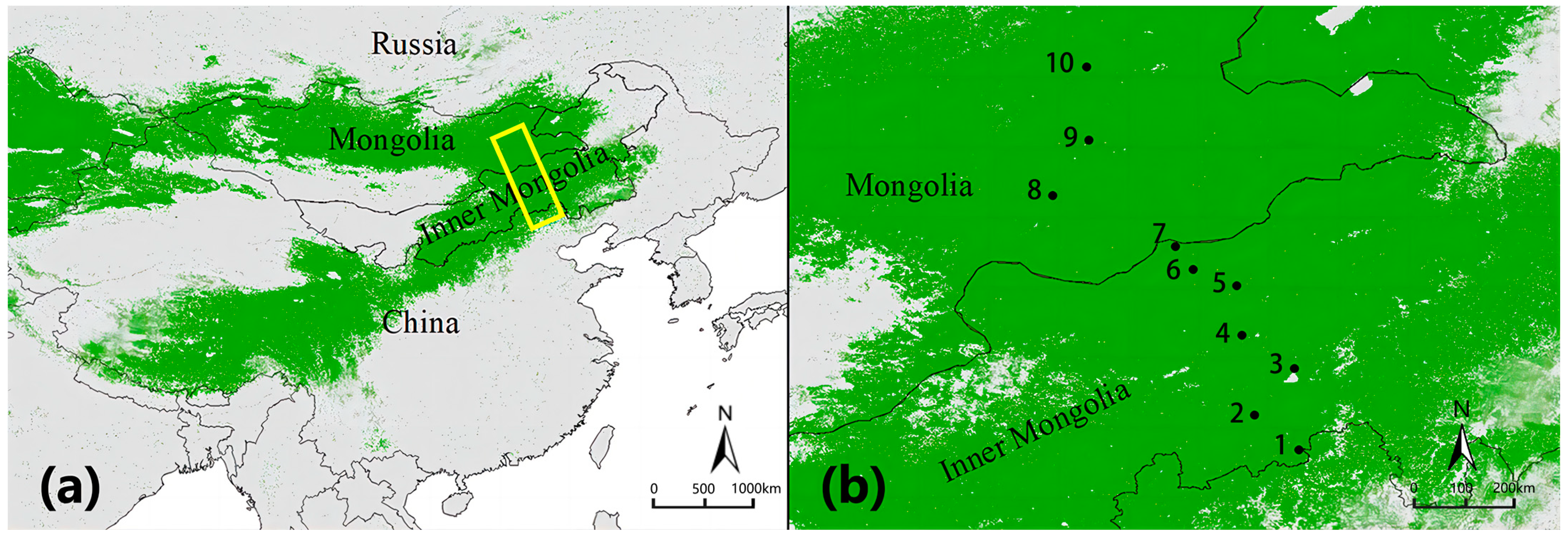

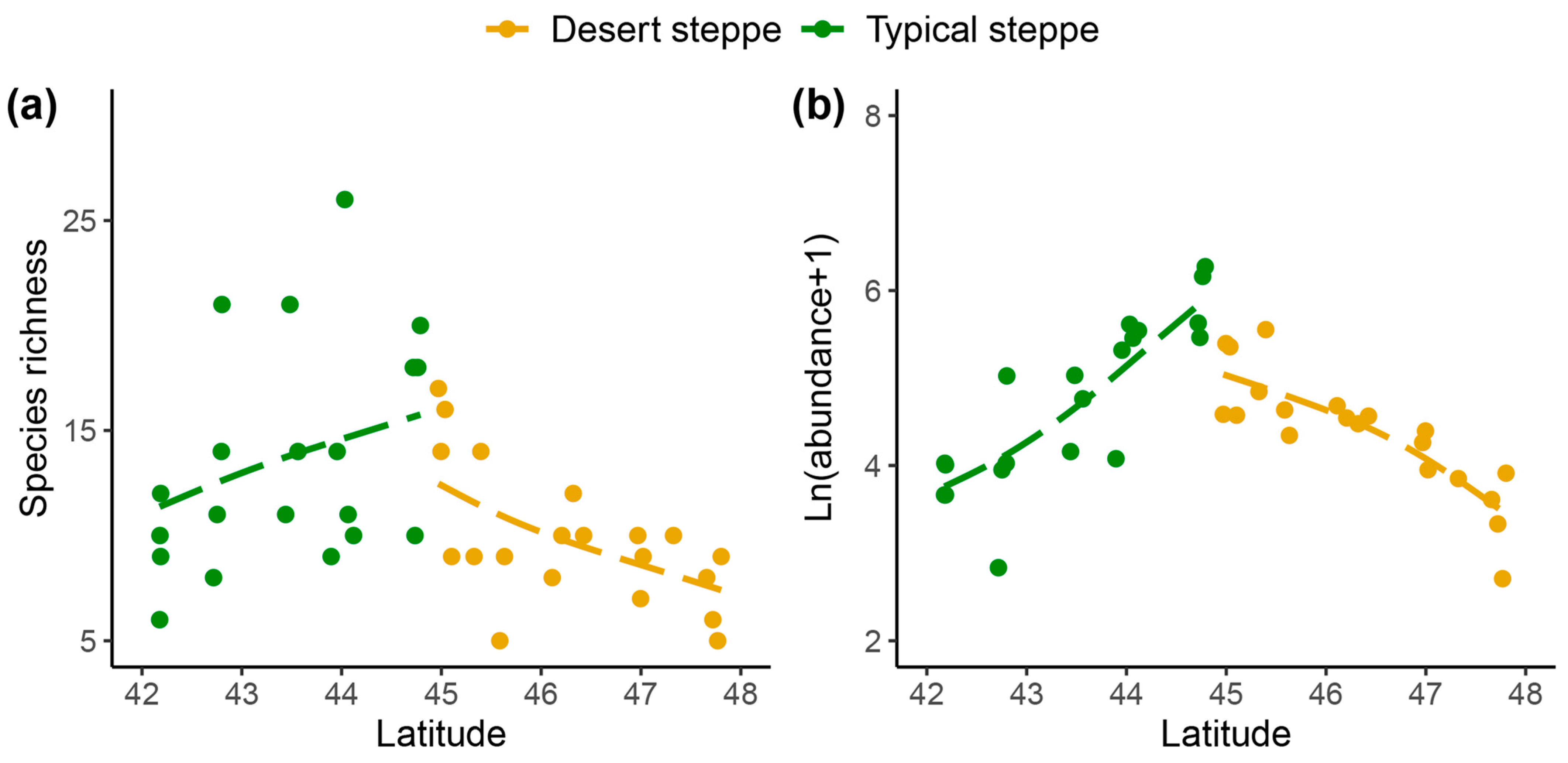
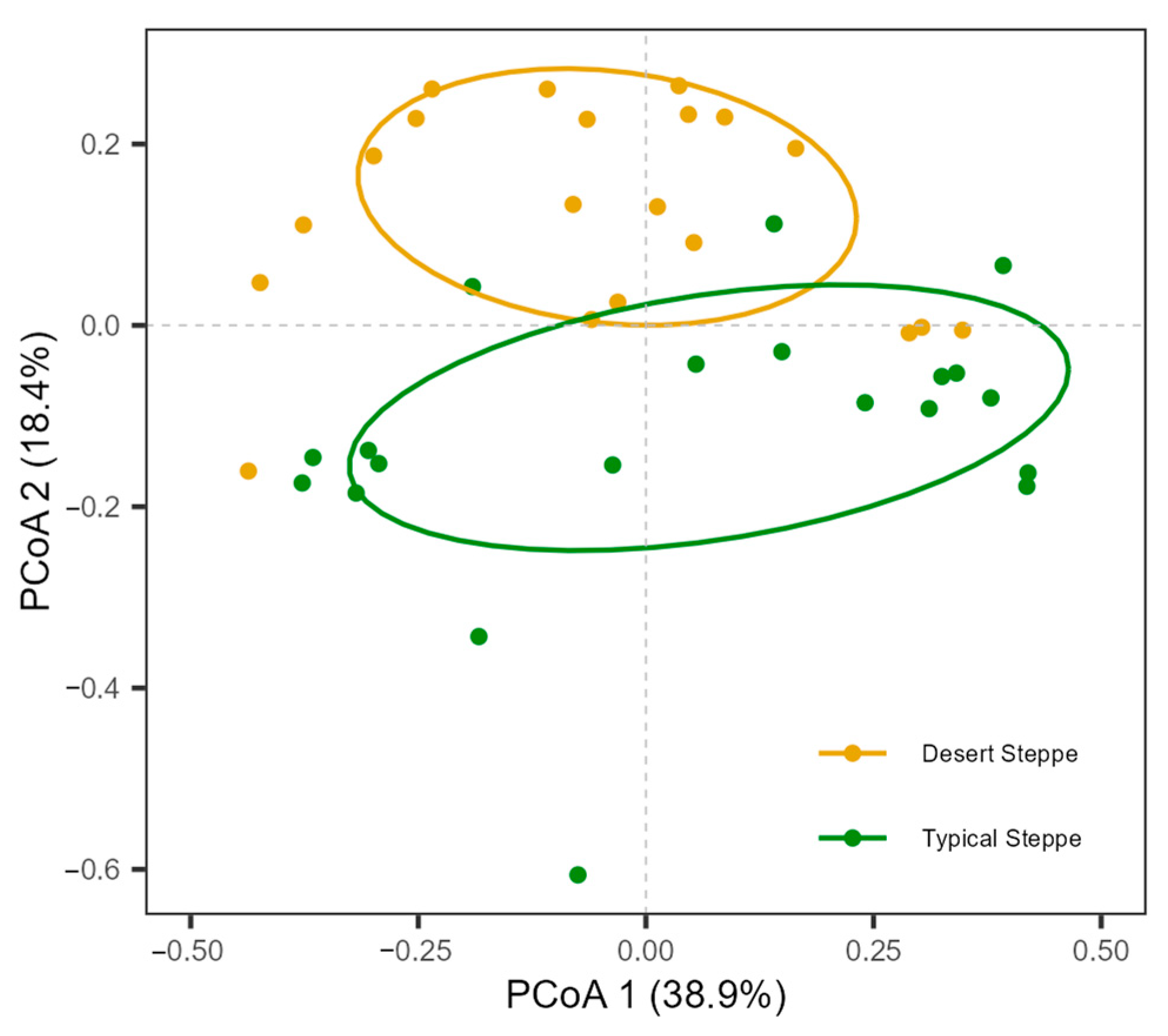
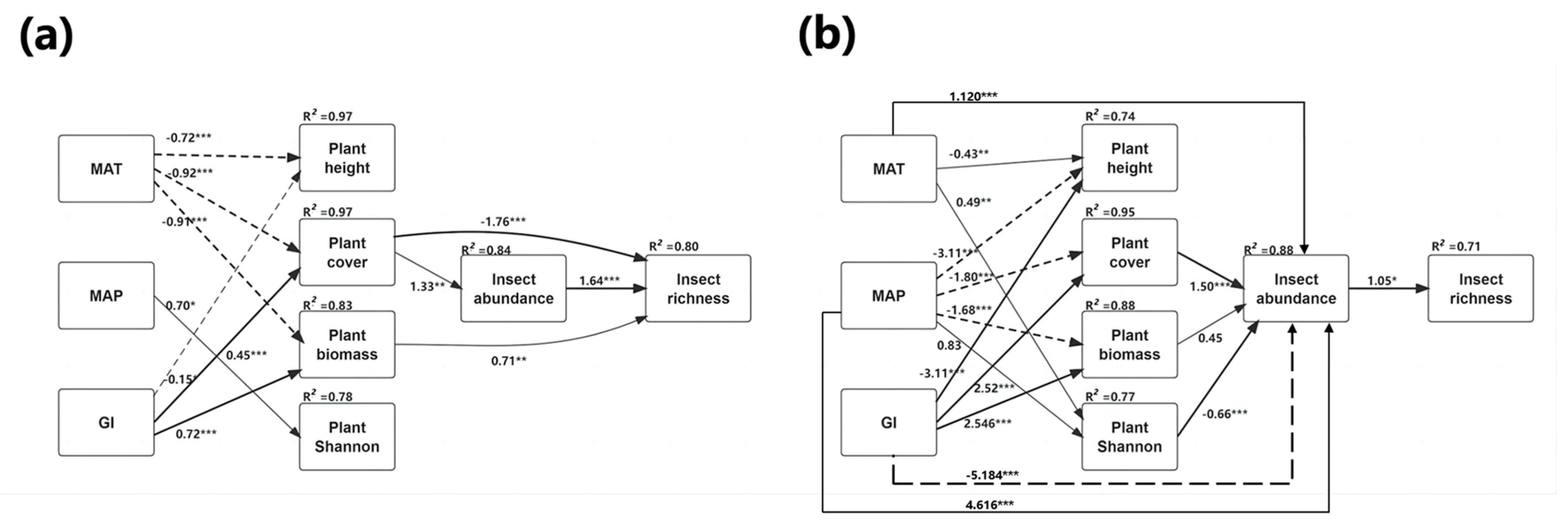
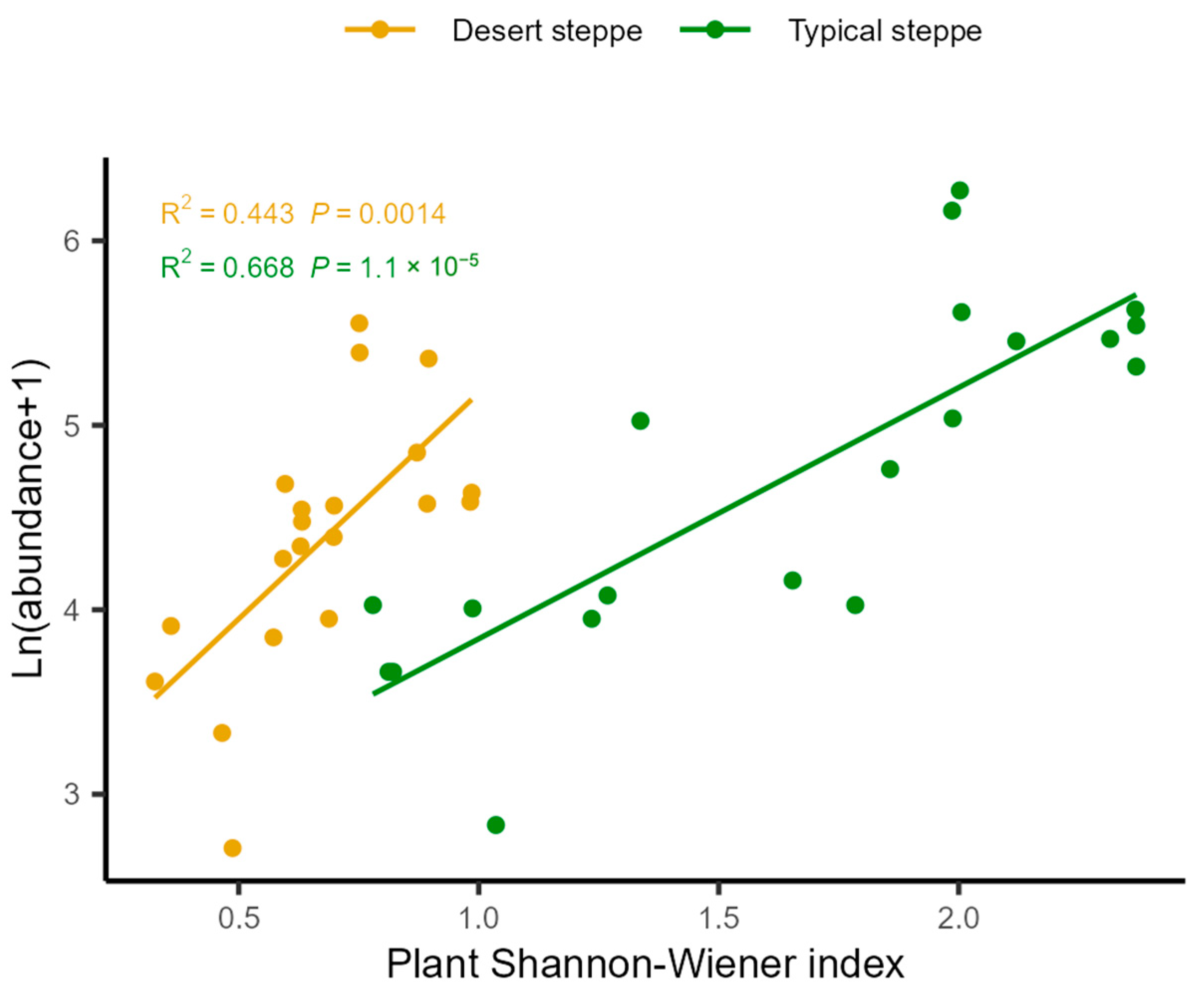
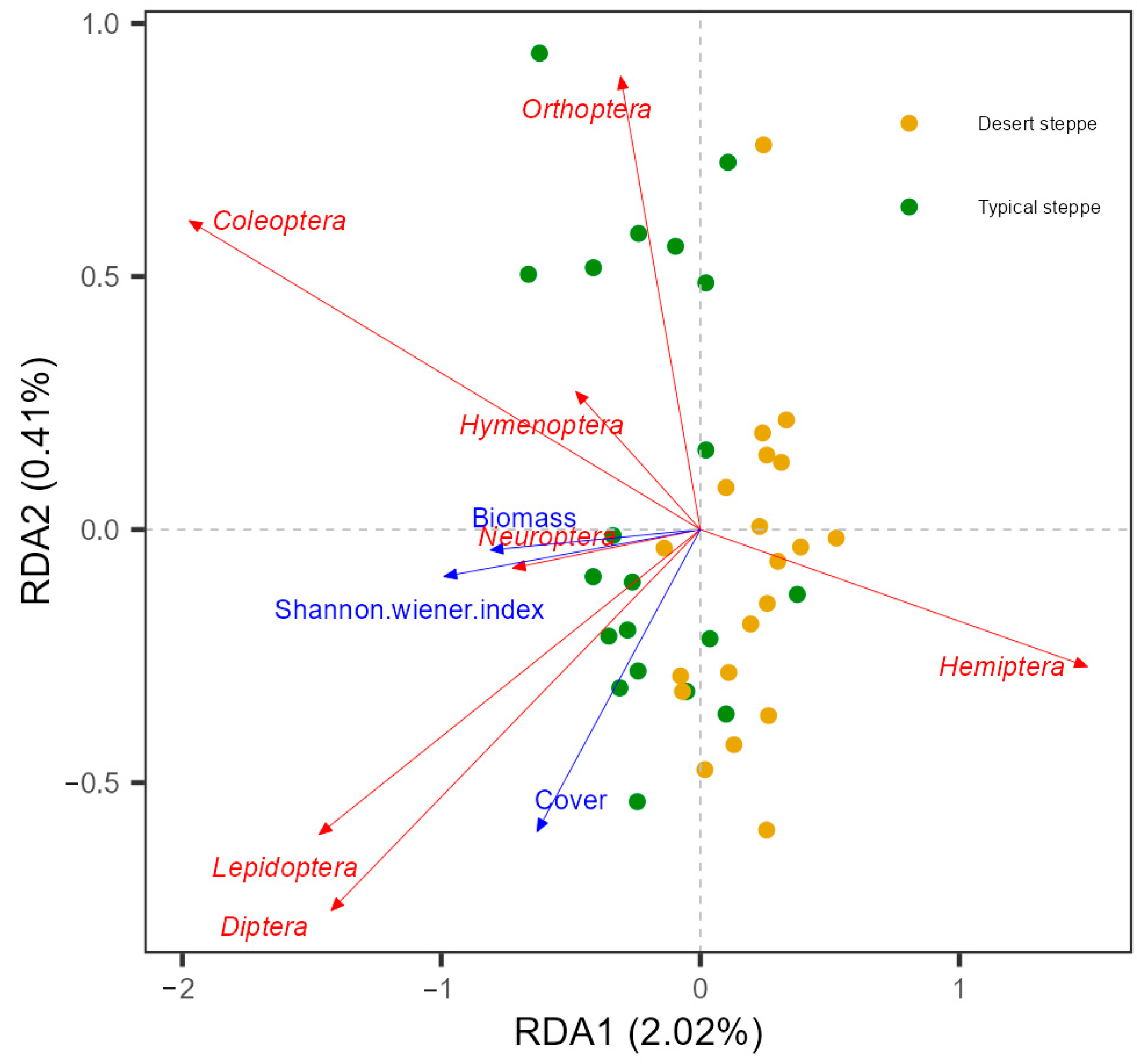
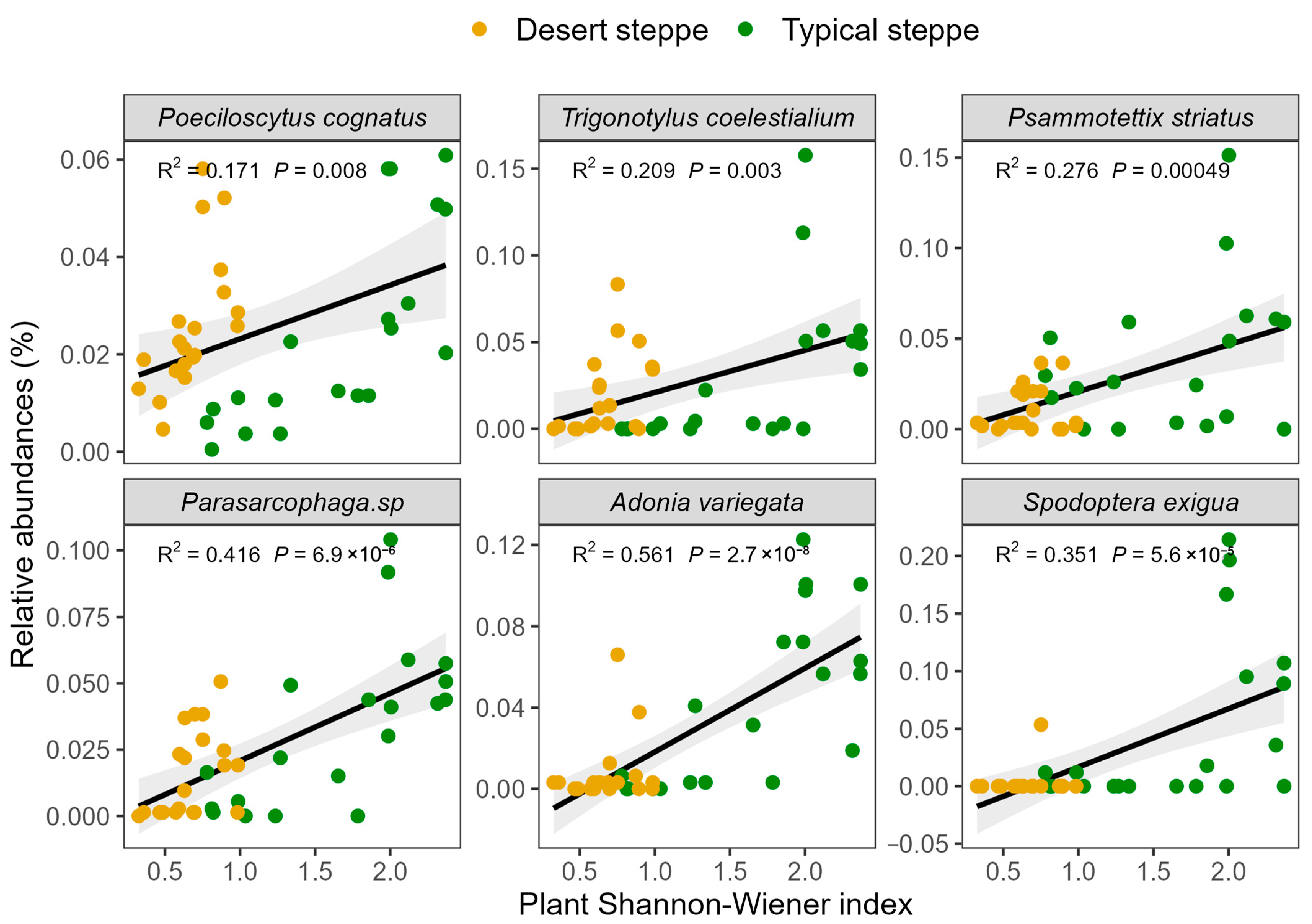
| Number | Site | Steppe Type | MAT (°C) 1 | MAP (mm) 2 | GI (Sheep ha−1) 3 |
|---|---|---|---|---|---|
| 1 | Duolun, Inner Mongolia | Typical | 1.84 (0.011) | 367.88 (0.286) | 136.82 |
| 2 | Zhenglan Banner, Inner Mongolia | Typical | 1.85 (0.013) | 416.68 (0.437) | 63.43 |
| 3 | Dalinor, Inner Mongolia | Typical | 1.61 (0.041) | 416.74 (26.674) | 32.04 |
| 4 | Xilinhot, Inner Mongolia | Typical | 1.21 (0.038) | 458.84 (29.321) | 63.71 |
| 5 | Xilinhot, Inner Mongolia | Typical | 0.55 (0.053) | 486.52 (2.165) | 53.72 |
| 6 | Abaga Banner, Inner Mongolia | Desert | 0.19 (0.020) | 394.99 (0.568) | 51.53 |
| 7 | Abaga Banner, Inner Mongolia | Desert | 0.13 (0.029) | 388.93 (3.847) | 40.06 |
| 8 | Khaldzan, Sukhbaatar, Mongolia | Desert | 0.97 (0.355) | 204.31 (6.573) | 14.71 |
| 9 | Sukhbaatar, Sukhbaatar, Mongolia | Desert | −0.46 (0.278) | 243.53 (4.063) | 7.61 |
| 10 | Bulgan, Dornod, Mongolia | Desert | −1.69 (0.222) | 222.20 (1.620) | 4.91 |
| Effect | Typical Steppe | Desert Steppe | The Whole Transect | |||
|---|---|---|---|---|---|---|
| r | p | r | p | r | p | |
| MAT 1 | −0.01958 | 0.5236 | 0.343 | <0.01 * | 0.3655 | 0.0001 *** |
| MAP 2 | 0.1145 | 0.1228 | 0.0708 | 0.1386 | 0.06571 | 0.1513 |
| GI 3 | 0.2951 | 0.0175. | 0.2734 | <0.01 * | 0.3563 | 0.0001 *** |
| PH 4 | 0.0407 | 0.3529 | 0.03031 | 0.3846 | -0.01758 | 0.5553 |
| PC 5 | 0.02726 | 0.3426 | 0.3864 | 0.0001 *** | 0.1319 | 0.0229 |
| PB 6 | 0.004527 | 0.4652 | 0.3433 | <0.01 * | 0.2003 | <0.001 ** |
| PS 7 | 0.2369 | <0.01 ** | 0.2565 | 0.0134 | 0.1457 | 0.0275 |
| ENV 8 | 0.1809 | 0.0429 | 0.3099 | <0.001 ** | 0.2772 | <0.001 ** |
| GEO 9 | 0.3195 | <0.001 ** | 0.3649 | <0.001 ** | 0.3953 | 0.0001 *** |
Disclaimer/Publisher’s Note: The statements, opinions and data contained in all publications are solely those of the individual author(s) and contributor(s) and not of MDPI and/or the editor(s). MDPI and/or the editor(s) disclaim responsibility for any injury to people or property resulting from any ideas, methods, instructions or products referred to in the content. |
© 2023 by the authors. Licensee MDPI, Basel, Switzerland. This article is an open access article distributed under the terms and conditions of the Creative Commons Attribution (CC BY) license (https://creativecommons.org/licenses/by/4.0/).
Share and Cite
Song, X.; Ji, L.; Liu, G.; Zhang, X.; Hou, X.; Gao, S.; Wang, N. Patterns and Drivers of Aboveground Insect Diversity along Ecological Transect in Temperate Grazed Steppes of Eastern Eurasian. Insects 2023, 14, 191. https://doi.org/10.3390/insects14020191
Song X, Ji L, Liu G, Zhang X, Hou X, Gao S, Wang N. Patterns and Drivers of Aboveground Insect Diversity along Ecological Transect in Temperate Grazed Steppes of Eastern Eurasian. Insects. 2023; 14(2):191. https://doi.org/10.3390/insects14020191
Chicago/Turabian StyleSong, Xiaoxiao, Lei Ji, Guangming Liu, Xiao Zhang, Xiangyang Hou, Shujing Gao, and Ning Wang. 2023. "Patterns and Drivers of Aboveground Insect Diversity along Ecological Transect in Temperate Grazed Steppes of Eastern Eurasian" Insects 14, no. 2: 191. https://doi.org/10.3390/insects14020191
APA StyleSong, X., Ji, L., Liu, G., Zhang, X., Hou, X., Gao, S., & Wang, N. (2023). Patterns and Drivers of Aboveground Insect Diversity along Ecological Transect in Temperate Grazed Steppes of Eastern Eurasian. Insects, 14(2), 191. https://doi.org/10.3390/insects14020191







